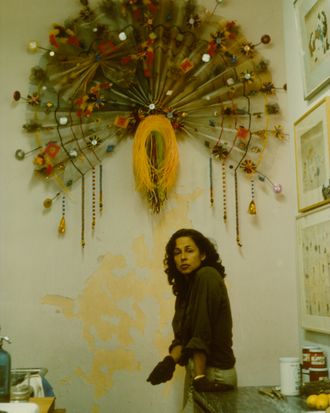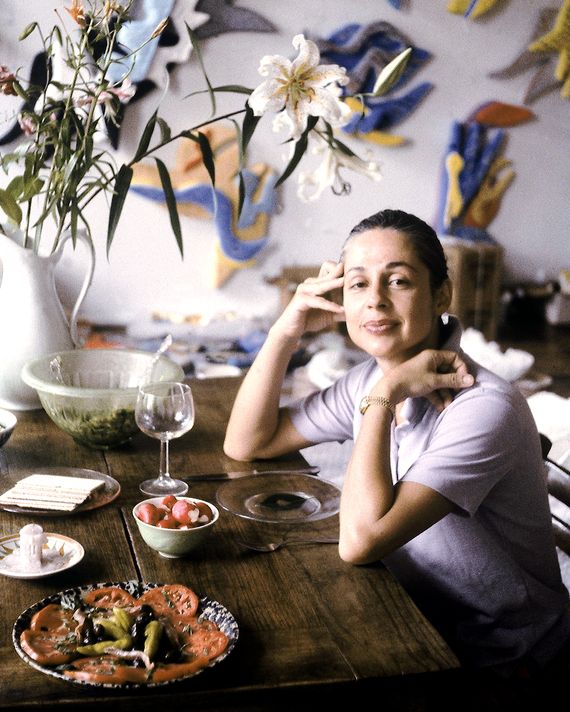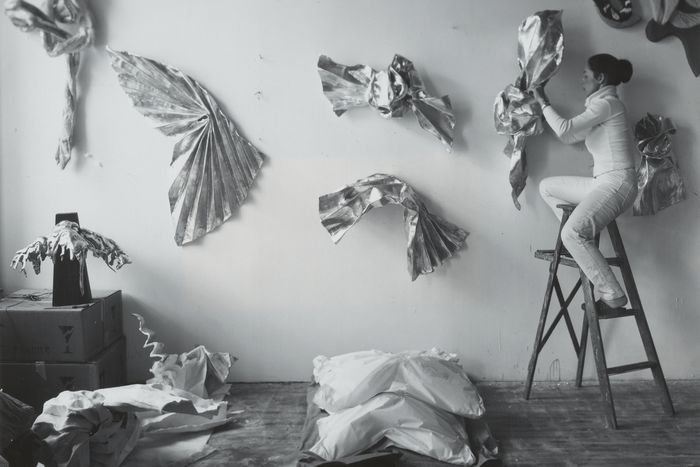
At 79, the legendarily irascible artist Lynda Benglis spends most of her time in Santa Fe, New Mexico, where she made much of the work for her current show at Pace Gallery. But she came up in the ragtag artists’ bohemia of the 1960s and ’70s. For a while she lived and worked at 222 Bowery, a former YMCA taken over by artists, including Fernand Léger, Mark Rothko, and William Burroughs, who referred to it as the Bunker. John Giorno, who lived there for more than 50 years, once called it “an Italian-inspired palazzo for the beggars.” Here, Benglis — notorious for her 1974 nude with a dildo advertisement for herself in Artforum — remembers her time there.
There was no other building with the wrought-iron gate. The building itself significantly had beautiful spaces and the largest studio belonged to Rothko. However, this building stands out from the Bowery presently, as nothing’s changed and it is opposite the New Museum, which in itself is an architectural statement. I first entered the building only because Mike Goldberg invited me to see his works, which were scaled up in power and gesture beyond what Rothko could have imagined. I was taken by their bombastic-ness, as the space and the paintings matched in scale. Mike was sporting Meledandri suits and then would appear in sinking jeans way below his waist with paint all over the floor and all over himself — quite opposite of the Meledandri image. Mike introduced me to Joan Mitchell. I was interested in Mike and Joan because they were considered the young artists when I was in school. At the time I had known of both Rothko and Mitchell since I’d read ARTnews in my painting years at Sophie Newcomb art school at Tulane University. Rothko had visited Tulane at the time, and the teachers there, including the graduate students, were actually doing terrific Abstract Expressionist paintings. So when I met Mike Goldberg coming into the Grove Press Bar, next door to Barney Rosset’s theater [Evergreen Theater], I unknowingly began to take part in the history of the ’50s and ’60s. The rest is history.
That being said, Mike Goldberg’s floating wall space was offered to me in 1970 in order that I might conceive of something larger, and right then and there I knew I wanted to have something come off of the wall. I was sick of planar brushstroke paintings and texture, and I wanted something to imitate paint. I had long been experimenting with different forms in both wax encaustic and natural rubber, and it was interesting to me that these materials were raw materials and that they came from places other than our country.
And then I did the Mike Goldberg piece [Wing, polyurethane foam, 1970]. I wanted to get it up on the wall in his space. I did my first wing on his floating wall that had to balance itself on the floor, so it went from the floor to the wall, but it tippy-tiptoed down to the floor. It was my first wing, and as a form it was very complete and very singular. It was a form of what could have been a monster underneath, but this was heavenly. It got off the dirty floor of Rothko’s and later Mike Goldberg’s studio, which had never been cleaned and was blackened with soot and paint from even yet another century.
I continued working, having studios elsewhere at Baxter Street and in L.A. At my previous studio on Baxter Street, the people who owned it went elsewhere. They loved me. They were always pleased when I came in. I paid maybe $65 in the beginning and it went up to $75. I left when a new owner bought the building. The Chinese were moving into Little Italy and became the new owners.
On the Bowery I also briefly rented this big place that I never really lived in, in the building where Klaus Kertess lived, on Bowery and Bond, procured by Jack the “Loft King” [Jack Levine]. He ended up becoming kind of a hippie. Klaus’s loft was really the Bykert Gallery storage. It used to be rented by Gordon Hart and had previously been occupied by Gerald Laing. The Bouwerie Lane Theater was underneath. I paid a lot of money a month and moved some stuff in there, but not much. Jack might have introduced me to another space on the Bowery. Brice and Helen Marden lived down the street. Who else lived there was Chuck Close. Tom Bronk lived at Leo Castelli’s storage on Canal Street. He was living at Leo Castelli’s storage and he was using Jasper Johns’s hot plate to cook. I took that and used it at Baxter Street. I think Tom is a great artist and I support Tom in his work. He’s part of the Bowery for me. He helped me get going.
When I signed the lease in 1977, 222 Bowery was in its 19th-century state and had been a YMCA. It was built in 1884. Bill Walton had my loft before I got it. He gave it up when he bought a large place on the corner in Hell’s Kitchen. He was a painter who made paintings of barbershop icons: red, white, and blue. He was a retired reporter from Washington, D.C., who escorted Jackie Kennedy to parties when she was married to the president. He had a fantastic home in Georgetown and a lovely home along the Hudson.
There were all kinds of vented areas in the ceiling of my space, round and square patterns of vented areas in the ceiling. In order to transform the space to my studio so that I could adhere heavier wax paintings to the walls, I covered all the working walls with three-quarter-inch plywood. Bill Jensen did the floating wall for me at the Bowery, which he floated with pipes. I didn’t want it to go all the way up. I wanted the beautiful eastern light of the Bowery. It’s excellent for painters.
I didn’t have anything in there. I had to clean up the space. The space was a mess. Mike’s was a mess. I bought one of the first Castro Convertible beds — secondhand, but brand new. It was a pullout, simple, but no back, and I remember that I also had bought a striped lightweight couch, which was mostly a sunporch-type couch — that and a Biedermeier table, which I bought after teaching briefly at Cal Arts. I bought an old secondhand file cabinet and painted it gray. That was mostly the extent of my furniture.
222 Bowery did not seem like a wonderful place, except for the people in it; it seemed to be floating only as a wonderful home, much like the old woman in the shoe. It does seem like the old woman in the shoe because everyone in the building was simpatico. And I especially spent a lot of time at Mike Goldberg’s as he had great parties. And when Lynn Umlauf moved in, I was over at Mike and Lynnie’s quite a bit, taking a break with a glass of wine and some really marvelous cooking. Mike was really best at the pasta when it came to cooking, and Lynnie liked to follow recipes in a concentrated and feral manner, which turned out to be a whiz when it came to eating. Prior to Lynnie’s moving in, I shared an old rusty portable shower upstairs on the third floor with John Giorno and Mike Goldberg. All of us had to go upstairs for what seemed like forever because it was not very convenient to be going up and down with a small or large towel.
Negative and positive space have equal dimension and weight in my world. And most sculptors think that way. I’ve commented along the way that the Bowery has equal positive and negative dimensions. The negatives and positives of the place: The stairwells are still a bitch, but there is the positive reinforcement of the people. The energy of the place still vibrates.
“Lynda Benglis: An Alphabet of Forms” is at Pace Gallery, through July 2.
"artist" - Google News
June 28, 2021 at 09:29PM
https://ift.tt/3y0sLRx
Artist Lynda Benglis Remembers Life at 222 Bowery in the 1970’s - Curbed
"artist" - Google News
https://ift.tt/2FwLdIu
Bagikan Berita Ini
















0 Response to "Artist Lynda Benglis Remembers Life at 222 Bowery in the 1970’s - Curbed"
Post a Comment